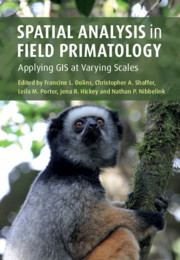Book contents
- Spatial Analysis in Field Primatology
- Spatial Analysis in Field Primatology
- Copyright page
- Dedication
- Contents
- Contributors
- Acknowledgments
- 1 Why Place Matters, and its Use in Primate Behavioral and Ecological Research
- Part I GPS for Primatologists
- Part II GIS Analysis in Fine-Scale Space
- Introduction
- 7 Home Range Analysis
- 8 Quantifying Resource Dispersion in Free-Ranging Bearded Sakis in Guyana
- 9 Interpreting Small-Scale Patterns of Ranging by Primates
- 10 Determining the Presence of Habitual Travel Route Networks in Orangutans (Pongo pygmaeus morio) in Kutai National Park, Borneo
- 11 Finding Fruit in a Tropical Rainforest
- 12 Random Walk Analyses in Primates
- 13 The Use of Small-Scale Spatial Analysis to Evaluate Primate Behavior and Welfare in Captive Settings
- 14 The Promise of Spatially Explicit Agent-Based Models for Primatology Research
- Part III GIS Analysis in Broad-Scale Space
- Index
- Plate Section (PDF Only)
- References
7 - Home Range Analysis
Why the Methods Matter
from Part II - GIS Analysis in Fine-Scale Space
Published online by Cambridge University Press: 29 January 2021
- Spatial Analysis in Field Primatology
- Spatial Analysis in Field Primatology
- Copyright page
- Dedication
- Contents
- Contributors
- Acknowledgments
- 1 Why Place Matters, and its Use in Primate Behavioral and Ecological Research
- Part I GPS for Primatologists
- Part II GIS Analysis in Fine-Scale Space
- Introduction
- 7 Home Range Analysis
- 8 Quantifying Resource Dispersion in Free-Ranging Bearded Sakis in Guyana
- 9 Interpreting Small-Scale Patterns of Ranging by Primates
- 10 Determining the Presence of Habitual Travel Route Networks in Orangutans (Pongo pygmaeus morio) in Kutai National Park, Borneo
- 11 Finding Fruit in a Tropical Rainforest
- 12 Random Walk Analyses in Primates
- 13 The Use of Small-Scale Spatial Analysis to Evaluate Primate Behavior and Welfare in Captive Settings
- 14 The Promise of Spatially Explicit Agent-Based Models for Primatology Research
- Part III GIS Analysis in Broad-Scale Space
- Index
- Plate Section (PDF Only)
- References
Summary
A quick search on Google Scholar in November 2019 indicated that Burt (1943) has been cited more than 2700 times. Although the general definition of home range by Burt (1943) is commonly referenced in studies that calculate the home range for a particular study group, the definition does not address which data one should use, the duration of data (length of study), the metrics for calculating home range, or (not surprisingly given that it’s been 70 years since Burt (1943) coined the definition) the type of software to use.
- Type
- Chapter
- Information
- Spatial Analysis in Field PrimatologyApplying GIS at Varying Scales, pp. 129 - 151Publisher: Cambridge University PressPrint publication year: 2021
References
- 1
- Cited by

